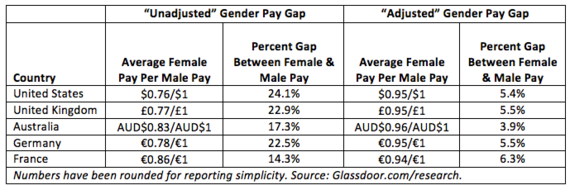In the early 1960s, the U.S. labor market was sharply divided. Only 37 percent of women worked outside the home. Newspapers routinely advertised jobs for men and women separately, often with separate pay scales. Women earned on average about 59 cents per dollar earned by men--giving rise to the famous equal-pay slogan "59 cents out of every dollar."
Since then, America has made progress. In 1963 Congress passed the Equal Pay Act aimed at eliminating the most egregious kinds of gender discrimination at work. In the 1960s and 1970s women's labor force participation rate rose steadily, as did enrollment in college and graduate programs. By 1990, women earned on average 72 cents per dollar earned by men. By 2005 that figure had risen to 77 cents per dollar.
However, this progress toward gender pay equality at work has stagnated in recent years. Today, the gender pay gap remains around 75-80 cents per dollar on average, and hasn't budged in a decade. Despite this reality, a recent Glassdoor survey of adults in seven countries found the majority don't even believe a gender pay gap exists--despite a mountain of economic research showing otherwise.
How can we move the needle toward greater awareness and pay equality? One of the first steps is to carefully measure the pay gap and what's causing it. Once we understand causes, we can pinpoint workplace practices and public policies that will help improve gender equity in today's labor market.
That is the subject of our latest research paper from Glassdoor titled, Demystifying the Gender Pay Gap. Our study examines the gender pay gap and its causes using a unique data set of hundreds of thousands of online Glassdoor salaries. We analyzed male-female pay differences in five countries: the United States, the United Kingdom, Australia, Germany and France.
Unlike many academic studies, we were able to include detailed information about specific job titles and companies in our study. That allowed us to make a careful apples-to-apples comparison between men and women working in similar jobs with similar backgrounds to see what the gender pay gap really looks like when we peel back the layers.
Sizing Up the Pay Gap
Our study finds an undeniable gender pay gap in Glassdoor pay data, both in the U.S. and around the world. Men earn more than women on average in every country we examined, both before and after adding statistical controls for personal characteristics, job title, company, industry and other factors designed to make an apples-to-apples comparison between workers.
In the U.S., men earn on average 24.1 percent higher base pay than women in Glassdoor salaries. That amounts to women earning about 76 cents per dollar earned by men. However, once we compare workers with similar age, education and years of experience, that gap shrinks to 19.2 percent. Going further, when we compare workers with the same job title, employer and location, the U.S. gender pay gap is about 5.4 percent.
That amounts to women earning about 94.6 cents per dollar earned by men. At today's real median earnings for full-time working women of $39,621, that is a pay loss of $2,140 per year or more than $64,100 over a 30-year career.
In all five countries we examined, we find a similar pattern: A large overall gender pay gap, which shrinks--but never fully disappears--when we account for differences in the education, experience, jobs and industries of men and women. It is remarkable that a significant gap persists even after we compare male-female worker pay at the job title and company level.
What's the Main Cause?
What is causing these persistent pay gaps? In our study, the single biggest cause we found is sorting of men and women into jobs and industries that pay differently throughout the economy. In the U.S., this occupational sorting explains 54 percent of the overall or "unadjusted" pay gap--by far the largest factor. For example, Census figures show women make up only 26 percent of highly paid chief executives but 71 percent of low-paid cashiers. By contrast, differences in education and experience between men and women explain only a small part of the pay gap.
Why do men and women tend to work in different jobs and industries in the economy? Past research suggests it's due largely to social pressures that divert men and women into different college majors and career tracks early in life, and gender norms such as women bearing disproportionate responsibility for child and elderly care that pressure women into lower paying but more flexible jobs.
Taking Steps Toward Equal Pay
Understanding causes of the gender pay gap is the key to achieving pay equity going forward. Although the "smoking gun" of overt workplace bias was the main driver of gender pay inequity in the early 1960s, today the main causes are subtler. The data show that outright discrimination isn't likely the main driver of today's overall gender pay gap. Instead, it's mostly due to occupation and industry sorting of men and women into systematically different jobs. But even after those factors are accounted for, the remaining 5.4 percent "adjusted" gender pay gap in the U.S. is a significant workplace problem all Americans should be concerned about.
What policies can best address the remaining gender pay gap? One solution may be promoting greater pay transparency in the workplace--something new rules recently proposed by the White House aim to accomplish. The research clearly shows that embracing salary transparency can help eliminate hard-to-justify gender pay gaps in the workplace--without information on who is being paid what, it's easy to see why gender inequities could persist for years undetected on employer payrolls.
As America strives toward gender equality in the workplace, pay transparency can play an important role in helping traverse the last mile toward full equality in male-female earnings in the workplace.
Contribute to the conversation about pay equality by sharing your salary on Glassdoor.
This article was originally published on Glassdoor Economic Research.
